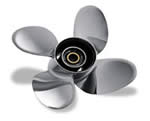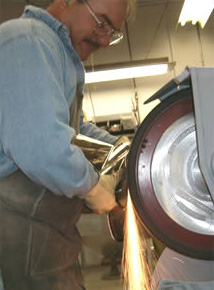Many neglect to consider the importance of their propeller. The propeller is the final link that connects the horsepower to the water.

(For definitions of various terms used in this article please visit Props 101)
Shape and Size
Propellers come in a wide variety of shapes and sizes. Those sizes are referred to as diameter and pitch. The first and most important decision when picking a propeller is to match the propeller pitch to the engine manufacturers recommended WOT (wide open throttle) range. This means it is important to be able to turn the minimum rpm the engine was designed for with the throttle fully advanced. As a propellers pitch rises, it creates a larger weight or restriction for the engine to spool up to higher rpm’s. A 50 horsepower engine may only be able to turn a 15-pitch propeller where as a 750 horsepower offshore race engine may be able to turn 30 plus inches of pitch. Once the correct pitch is determined, the plot thickens…
 Diameter
Diameter
Diameter can also affect both rpm capabilities and a number of other boat and hull personalities. Many of the diameter choices have been predetermined for the consumer by the propeller manufacturer. In most non-high performance applications, this works quite well. However, fine tuning diameter can greatly improve overall performance. Adding diameter will typically decrease rpm, while reducing diameter will raise the rpm. Diameter adjustments will also change the hulls running attitude. Changing the diameter is not always necessary since the stock diameters can be matched to the type of propeller a person is buying. To be more specific, we can look at the basic Bass boat propeller being made available to the general public in 13 ½ inches to 14 3/4 inches. While standard stern drive boats have diameters starting in the 14 inch realm and extending to the 15 ½ inch diameter. Large “go fast” boats with special stern drives can use propeller diameters ranging from 15 inches to 18+ inches. House boats and slow moving non-planning hulls may use diameters well into the 20 and 30 inch areas.
Number Of Blades
The number of blades on a propeller also affects the consumer’s decision when shopping for a new propeller. In theory, the least amount of blades will offer the best top speeds. The reasoning behind this derives from the fact that more blades create more metal in the water therefore more drag. However, if a boat is running inefficiently, more blades could become a positive since the additional blade area may give the boat better ability to “hook up” and perform better though out the torque band. The particular application the boat is being used in will help the operator to determine the number of blades needed to gain the best results.
Picking the right propeller can be confusing. There are many other considerations besides those which we’ve discussed here that can come into play. Speaking to a trained professional is the best way to get the most out of your boat, engine, and propeller set up. Most of the time, a boat will come with some type of propeller or propellers that will suffice to get you from point A to point B. True dialing in of your propellers should start with your dealer and can end with a reputable propeller specific shop or business. The most important starting point is to know the engine or engines capabilities. Prop the boat to run some where within the recommended wide open throttle range. Once this is done, the engine package can not be damaged from improper rpm due to propping. From this point the consumer can decide if he or she wants to take it to the next level of performance.


